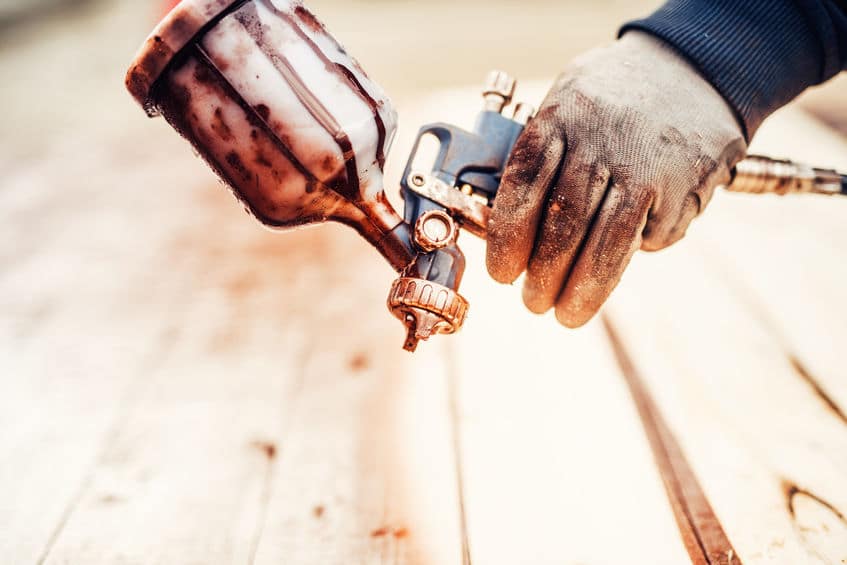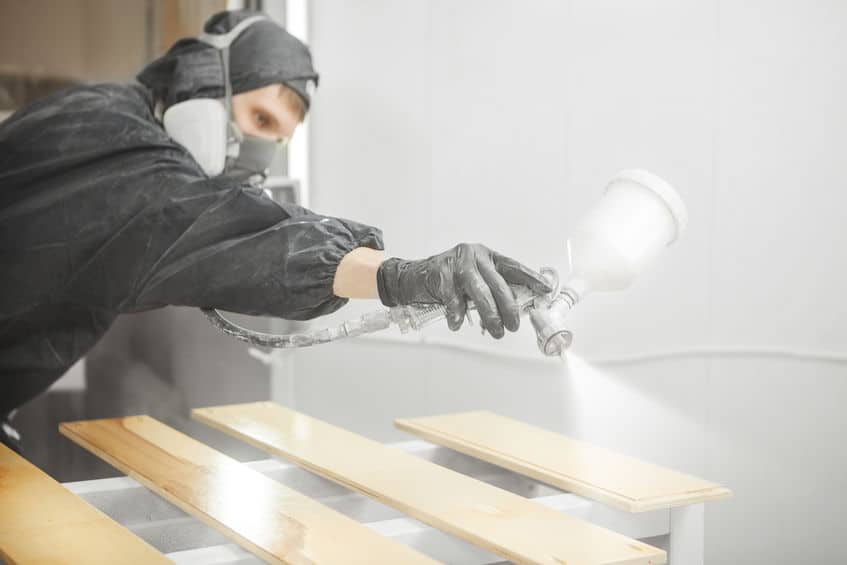Low Volume Low Pressure (LVLP) and High Volume Low Pressure (HVLP) spray guns can both be used for woodworking applications, but they have some distinctive operating qualities that make them work differently. Therefore, depending on which type of spray gun you choose, you may end up getting a very different result.
While they are messier and use more materials, HVLP spray guns can get a woodworking project sprayed much faster and with less finishing work to be completed afterward. The type of spray gun that is better for your woodworking depends on how much overspray you can tolerate in terms of spray efficiency and workspace cleanliness.
Both LVLP and HVLP spray guns are good at some aspects of woodwork painting and worse at others. Keep reading to learn more about how these spray guns can be used in woodworking projects and which is the better option for you.
What Is LVLP?
LVLP spray guns are a type of spray gun designed to spray materials such as paint or varnish at a low level of force. In woodworking, this can have some major benefits, such as being compatible with waterborne paints that wouldn’t work in an HVLP setup, as well as a very efficient transfer of materials.

If you’re working with an expensive varnish or stain in a woodworking project, it can be a good idea to try to limit the number of wasted materials as much as possible. This is even more important for woodworkers who are trying to turn a profit with their hobby since every penny counts when it comes to reducing overhead shop costs. Another advantage moneywise with the LVLP is that they don’t require a high-powered compressor to run.
LVLP spray guns are not the easiest gun on the market to find since other types of spray guns are more prevalent, but especially in small workshop areas, they can be a good choice since they largely prevent the accumulation of overspray from the gun. This is because the LVLP spray gun sprays with a small fan area of effect, so you end up with less paint or varnish on your floor, walls, and workshop furniture.
However, some drawbacks come with a low area of effect, too. Because the LVLP spray gun can’t spray as widely or as quickly as an HVLP setup, you’re more inclined to deal with an uneven cover or other blemishes that will have to be fixed afterward through sanding or multiple coats to achieve a smooth, professional-looking finish.
In summary, here are some of the pros and cons of LVLP spray guns (Source: HomeGearX):
| Pros | Cons |
| Less wasted paint and varnish | Doesn’t paint as quickly as an HVLP setup |
| Keeps workshop area clear of overspray | May require multiple coats or finishing work |
| More control over the operation | Doesn’t work well with metallic paints |
| Better for waterborne paint projects |
What is HVLP?
In contrast to LVLP spray guns, HVLP guns are much more common to find at home improvement stores and department stores. Most of the spray guns you see when entering the tool section of a shop are HVLP models.
Why are these spray guns easier to find than LVLP guns? A large part of it is their speed. Even though HVLP spray guns naturally end up wasting a higher percentage of materials (30-40% of paint is overspray in comparison to LVLP guns, where the percentage is closer to 20%), they can cover a lot more ground faster than an LVLP setup. Therefore, for large pieces, an HVLP spray gun can get the job done much more quickly.
Another advantage is the coverage area of the HVLP gun compared to the LVLP gun. The larger fan width of the HVLP’s spray lets the operator cover the piece more evenly. This can lead to less necessity to add multiple coats of paint or to spend hours sanding down uneven coats later. HVLP guns are known for giving a high-quality, consistent finish.
The biggest disadvantage of HVLP spray guns is overspray. Not only does this lead to more paint and varnish fumes during a job, but it also increases the build-up of overspray on surrounding areas in the workshop. So, with an HVLP gun, you’ll have to spend a lot more time prepping your paint area to make sure excess paint doesn’t end up on everything.
Here is a link to the closest gravity-fed gun I could find to what I use. This is an Amazon link so feel free to shop around to find the best fit for you.
These are some of the pros and cons of HVLP spray guns (Source: Tool Nerds):
| Pros | Cons |
| Easier to find | More wasted materials |
| Wider spray effect | Overspray mess in the workshop |
| High-quality finish | Needs a high-powered compressor to work |
| Fewer coats and sanding | |
| Faster paint job |
What Is the Main Difference Between LVLP and HVLP Spray Guns for Woodworking?
The single biggest difference between an LVLP spray gun and an HVLP spray gun is that the HVLP spray gun will require a larger air compressor to operate at a higher volume without losing spray efficiency. Luckily, these small air compressors are fairly inexpensive and can be had for just a few hundred dollars. As far as an investment in your home-based woodworking shop, you could do a lot worse.

On the technical side, the main difference between LVLP spray guns and HVLP spray guns is that LVLP spray guns operate at less than ten pounds-per-square-inch (psi) while HVLP operates anywhere above ten psi, depending on the model and functionality of the gun. The higher psi required by an HVLP spray gun is the reason why it requires an air larger capacity air compressor.
Both LVLP and HVLP spray guns are designed for the same thing—mechanical application of paint or varnish that removes the need to use a hand brush. Not only does it make a woodworking finish job much faster to use a spray gun, but you can also achieve a much more consistent result.
In some cases, if you’re doing a rustic piece, a hand-brushed effect may be the one you’re going after. But in the case of varnishes and most paint jobs, you’ll want to achieve as smooth of a coat as you can, without runs or thin patches.
What Kind of Air Compressor Do I Need for a Woodworking Spray Gun?
One of the biggest things you need to think about if you decide to get an HVLP spray gun setup for your woodworking shop is the air compressor. Unlike LVLP spray guns, you’ll need one to operate a spray gun with a higher psi properly.
There are two main categories of air compressors: oiled compressors and oil-less compressors. Traditionally, oiled compressors have been considered the quieter and the more high quality of the two types. However, recent innovations in oil-less compressor technology have led to a greater equivalency between the two model types.
Here are some of the other considerations you need to think about when choosing an air compressor for your woodworking spray gun (Source: Paint Sprayer Magazine):
- The sound of the compressor: As far as motor power goes, you’ll also want to look for an air compressor that is on the quiet side when it comes to motor operation. This is especially important if you’re going to be doing a lot of paintwork on your woodworking since extended exposure to loud noises—even with ear protection—can lead to hearing damage and loss.
- The portability of the compressor: It’s also a good idea to look for an air compressor that is small enough to be transported either to different locations or at least to opposite ends of the workshop to let you manipulate your spraying space. Depending on the size and scope of the woodworking project, you may need to move into a larger paint booth to work efficiently without making a mess. Portable compressors also take up less space.
- The motor power of the compressor: When looking for an air compressor to run an HVLP spray gun, you’ll need to look for an air compressor that runs at around 1-2 horsepower. This should be enough motor power to be able to push paint effectively through the spray gun. There are compressors available with more horsepower, but they tend to be energy hogs, and spray applications don’t require the extra force.
- The tank size of the compressor: The LVLP spray guns require less volume and can run efficiently with the smaller air tanks. HVLP spray guns will be better served by running tanks 20 gallons or over.
There are tons of air compressors available on the market, so be sure to do a little comparison shopping before you commit to a certain model. They come in a wide variety of colors, shapes, and range of mechanical power.
These are some of the best small capacity air compressors suitable for LVLP available on the market:
- California Air Tools Air Compressor
- Bostitch Pancake Air Compressor
- Craftsman Air Compressor
- Senco Air Compressor
- Porter-Cable Air Compressor Kit
Most air compressors lie in the same relative price range, so your main concern when finding a good one for your woodworking projects is going with a brand that has a good reputation for customer satisfaction, as well as an air compressor that is known for durability and ease of use.
The best way to find a good air compressor for your woodworking paint gun is to check out customer reviews and see what people who bought the air compressor have to say about its functionality. Customers are often a lot more forthcoming about the disadvantages of an air compressor post-purchase than the vendor is.
Which Type of Spray Gun Is Better for Varnish and Paint?
So, we’ve gone over all of the things that make an LVLP and an HVLP spray gun setup different. Which of them is better for woodworking varnish and paint applications? The truth is that it depends on several different factors which of these spray guns are going to be the better choice for your woodworking jobs. (Source: Sprayer Guide)
These are some of the questions you should ask yourself to help figure out which would be a better spray gun choice for you:
- Do you have the extra money for the larger HVLP air compressor? If your woodworking budget doesn’t include an extra few hundred dollars for an air compressor (and the extra electricity to run it), you might want to look into an LVLP setup.
- How large is your woodworking paint area? Keep in mind that HVLP operations include a lot of overspray, so you’ll have to be vigilant about protecting enclosed areas from excess paint. You’ll also need plenty of ventilation. LVLP spray guns don’t spray as widely and can be controlled easily in small spaces.
- Are you trying to run a business with your woodworking? The higher volume of applications in HVLP spray guns can allow a woodworker to complete more projects faster in a business scenario, but the high level of overspray also means a lot of money lost in wasted materials. It’s a balancing act as to which setup is potentially more profitable and depends a lot on the individual woodworker and their processes.
- How much noise can you tolerate? An HVLP spray gun utilizes a larger air compressor, which makes it a naturally louder process to paint and varnish with. The frequency of this repetitive noise can be grating for some woodworkers, even with ear protection.
- Do you mind having to apply multiple coats? LVLP spray guns are easier to control, but because they don’t cover as much of the painting surface at once, you’ll have to spend more time painting and will have to do many coats to end up with a smooth finish. With LVLP paint jobs, you’ll also have to sand out imperfections like runs or other trouble spots in the paint when you’re done.
- How large are your woodworking pieces? HVLP spray guns are a better choice for large spray jobs such as picnic tables or porch swings, but an LVLP spray gun is probably better suited for spraying small objects since you’ll end up with less overspray. For large projects, HVLP spray guns just cover more area faster, so you’ll spend less time painting.
Advantages of Spray Painting in Woodworking Versus Hand Painting
When many people think of a woodworker varnishing their finished work, they see an artisan carefully hand-brushing the stain onto completed carpentry. Hand-brushing paint and varnish can be a nice look in some projects. However, in many others, woodworkers are much more interested in a smooth uniform finish to the piece they worked so hard on.
Here are some of the advantages of buying a spray gun to paint your woodworking projects instead of painting them by hand:
- Uniformity: The fan spray of a spray gun just coats wood with paint more evenly than doing it by hand, and you end up with no brush strokes in the paint or varnish, just like you would have if you painted by hand. This allows the paint or varnish to maintain the same thickness and coloration across the entire piece. Without uniformity, thicker or thinner patches of paint will be painfully obvious on a larger woodworking project.
Hard-to-reach places: Many woodworking projects such as chairs or other furniture have a lot of small areas that can be difficult to reach and paint evenly with a hand brush. Not only is the finished product not as even as it could have been if you’d used a spray gun, but it’s also a much more tedious process to paint by hand. This is because you’re likely to need additional coats for a manual paint job, too. - Speed: Without the efficiency of a mechanical spray gun, painting and finishing your woodworking piece is probably going to be a multiple-day affair, especially when you include the dry time between coats. In comparison, the warm air used to spray an HVLP spray gun helps coats of paint dry faster and more evenly without having time to run.
- Less clean-up: Trying to get paint and varnish out of hand-held brushes can be a time-consuming end to a hard day of work in the shop, but spray gun setups take a lot of the sting out of shutting your woodworking space down for the day. While spray guns and their components will still need clean-up, it’s usually much easier than trying to get paint and varnish out of bristle brushes for half an hour.
There are a few rustic or “distressed” woodworking projects that might require a manual paint or varnish job, but there are many others where investing in a spray gun setup can save you a ton of time, money, and energy. The faster you get the paint job done on your woodworking project, the faster you can move on to the next one.
HVLP Spray Guns Are Better for Many Woodworking Projects
Because of their efficiency and their ability to get a consistent, high-quality finish, an HVLP spray gun is the superior choice for many woodworking projects. While LVLP spray guns may be less messy, they’re also a lot slower, and the amount of overspray difference isn’t enough to justify the decreased power and area of effect.
For those who do not have an air compressor, who need to work in a small workshop space, or who need to do waterborne paint projects, an LVLP spray gun is the better option.
